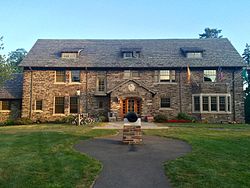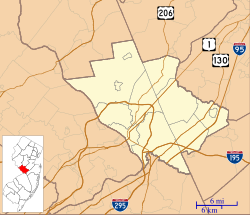Cannon Club
|
Cannon Club
|
|
 |
|
| Location | 21 Prospect Ave, Princeton, New Jersey |
|---|---|
| Coordinates | 40°20′52.1″N 74°39′12.1″W / 40.347806°N 74.653361°WCoordinates: 40°20′52.1″N 74°39′12.1″W / 40.347806°N 74.653361°W |
| Built | 1910 |
| Architect | Edgar Viguers Seeler |
| Architectural style | Collegiate Gothic |
| Part of | Princeton Historic District (#75001143) |
| Added to NRHP | 27 June 1975 |
Cannon Club, also known as Cannon Dial Elm Club, is one of the historic Eating Clubs at Princeton University. Founded in 1895, it completed its current clubhouse in 1910. The club closed in the early 1970s and later merged with Dial Lodge and Elm Club to form Dial, Elm, Cannon (DEC), which closed its doors in 1998. In 2011 DEC reopened, now bearing the name Cannon Dial Elm Club, using its historic clubhouse, which had served as the home for the Office of Population Research during the club's hiatus.
The Eating Clubs play a central role in the history and life of Princeton University, serving as the primary place of dining and social life for more than 70% of upperclassmen. Cannon Club was founded in 1895 and housed in a small house on William Street that had been home to Tiger Inn for the previous two years. From 1896-99 it was located in the "Incubator" a small house, at that time on Olden Street, that served as an early home to many of the Eating Clubs as they established themselves and sought to build clubhouses. In 1899, Cannon Club purchased the Osborn House that stood on the south side of Prospect Avenue, between the McCosh and West residences. That home fell into disrepair by 1908 and Edgar Viguers Seeler, a prominent Philadelphia architect, was commissioned to build a new clubhouse. That Collegiate Gothic clubhouse, completed in 1910, was the first of the clubs to make use of local stone. While the facade has been described as plain in comparison with other clubs, the rear elevation and interiors have been praised, with the two-story living room considered one of the finest interior spaces found on Prospect. The eponymous cannon sits in front of the clubhouse, pointed at Prospect Avenue. President-elect Woodrow Wilson, on a last stroll before departing for Washington, commented to reporters: "Hardly a chummy entrance that!"
The club was famous for its debauchery, gaining a reputation as the Animal House of the university. One story from 1966 relates a nighttime coed nude volleyball game during Houseparties, the annual Princeton formal dance, though the club's own history disputes that it was coed. In the late 1960s the club gained a reputation for destructive behavior, including the destruction of a wall in neighboring Campus Club with sledgehammers, and the laceration of an artery of club president Michael Ryan while being passed down the stairs. The club also became known for racial prejudice. In May 1969, a group of Cannon Club members threatened several African-American students with knives, chains, and brass knuckles, leading to the expulsion of one club member and suspension of another. The same year, an instructor's pregnant wife was accosted and held off the ground while three club members gunned beers at her. The notoriety led to a fall in membership, ultimately precipitating the closure of the club in the early 1970s. The property came into the possession of the University, which spent 3/4 of a million dollars on renovations and deferred maintenance to turn the clubhouse into an academic building, Notestein Hall, which housed the Office of Population Research for over 30 years.
...
Wikipedia



